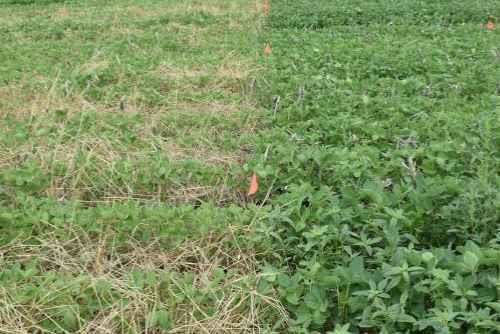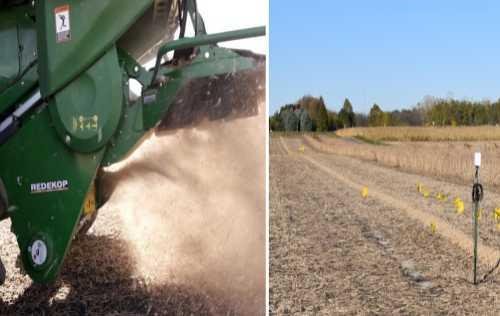Glyphosate is the most effective herbicide for chemical termination of cereal rye cover crop. Other typical grass herbicides belonging to group 1 (HG 1) or group 2 (HG 2) are not very effective on grasses taller than 4 to 6 inches. Among these herbicides, clethodim (Select Max or others) is more likely to provide a satisfactory control; however, its activity slows down under cool weather conditions. Nonetheless, terminating a cereal rye at 4 to 6 inches height will not provide weed suppression benefits of the cover crop. The only potential herbicide alternative is paraquat (Gramoxone), with a high carrier volume (to optimize spray coverage). Adding a triazine herbicide such as metribuzin improves the efficacy of paraquat in killing cereal rye prior to planting soybean. In addition, metribuzin will provide residual control of late-emerging weeds like waterhemp.
If growers have planted a cereal rye cover crop last fall and have only one shot of glyphosate available for use in soybean, it may be better to use it for cover crop termination. The amount of biomass accumulation by cereal rye at the time of termination directly correlates with the level and duration of weed suppression. Delaying the cereal rye cover crop termination until it reaches the anthesis stage will maximize weed suppression benefits. This stage can be achieved at or after soybean planting (referred to as planting green) depending on year and location.
Our research (Figure 1) conducted in Central Iowa in 2020 and 2021 indicate that a cereal cover crop terminated at or 7-10 days after soybean planting can accumulate sufficient biomass to reduce density and biomass (size) of marestail (horseweed) and waterhemp plants at the time of postemergence (POST) herbicide application (glufosinate, Liberty used in Enlist E3 soybean in our trials). This would be a “complimentary” strategy to enhance the efficacy of POST glufosinate for controlling these two troublesome weeds, with widespread occurrence of resistance to glyphosate and HG 2. This strategy will also aid in getting most out of glufosinate, which will be very critical for 2022. Addition of soil residual herbicides (HG 15) with the early-POST program would further extend the control of waterhemp that continues to emerge through August in soybean.

Figure 1. Waterhemp infestation in cereal rye (terminated at anthesis stage, planting green) cover crop plots (left) vs. no cover crop plots (right) in soybean at the ISU Bruner Farm near Ames, IA.
Roller crimping is a non-chemical option to terminate cereal rye cover crop. Roller crimper is most effective when used at early milk to soft dough growth stage of cereal rye. It takes longer for cereal rye to die when terminated with a roller-crimper vs. herbicides such as glyphosate. However, roller crimping can be beneficial as it keeps the ground covered for a longer period of time; hence, an extended duration of weed suppression. If none of the options mentioned above are available, mowing can be an alternative method for cover crop termination. A sickle bar, rotary, and flail mower can be used to mow down the cover crop prior to or at soybean planting. To avoid regrowth, cereal rye should be mowed at or after the flowering growth stage. Additionally, HG 1 herbicides can be used to prevent further regrowth of cereal rye in soybean.
Tool # 3: Narrow-Row (15-inch) Soybean
Planting soybean in narrow rows helps the crop to achieve canopy closure quicker, which causes a greater shading of weeds growing underneath the soybean canopy. Based on our research trials, soybean growing in 15-inch rows achieves canopy closure two weeks earlier than soybean growing in 30-inch rows. This also makes soybean more competitive against weeds by reducing the quantity and quality of light needed for weed seed germination and growth.
Quicker and dense canopy closure of soybean also enhances the efficacy of POST herbicides by reducing weed density, size, and biomass at the time of application. Research conducted by the ISU weed science program (2019-2021) indicate that a cereal rye cover crop provided greater suppression of waterhemp when soybean was grown in 15-inch compared to 30-inch rows. This “complimentary strategy” will be more important this year when dealing with herbicide shortage and increased herbicide costs. Reduced weed density and biomass puts less burden on subsequent weed control tactics. This will also be a best management practice to reduce herbicide selection pressure and seed bank inputs from waterhemp with evolved resistance to multiple herbicides (HG 2, 9, and 14) in soybean production fields.
Tool # 4: Harvest Weed Seed Control
Be mindful that weeds that escape or survive in-season control tactics can contribute significantly to the soil seed bank for future infestations. This is especially true for waterhemp, a prolific seed producer, with stacked resistance to five sites-of-action herbicides in Iowa corn and soybean fields (based on our recent survey results). Weed seeds at soybean harvest can be targeted and destroyed/managed using harvest weed seed control technologies. These are effective for species such as waterhemp that can retain 80% or more of seeds at typical soybean harvest dates in Iowa. The ISU weed science program has been testing two harvest weed seed control methods (Figure 2) widely adopted by Australian farmers in their war against herbicide resistance, namely weed seed destruction (high-impact cage mills) and chaff lining (concentrating weed seeds with chaff in a narrow band).

Figure 2. Testing two harvest weed seed control technologies in Iowa soybean production in 2020-2021: Redekop Seed Destructor (left, 92-95% physical destruction of waterhemp seeds that passes throug the high impact mills) and chaff lining (right, weed seeds concentrated in soybean chaff at the center of the combine (35-feet header width, therby reducing the spread of herbicide-resistant waterhemp seeds by 95% or more on a per acre basis).
Based on our multi-location on-farm trials conducted in 2020 and 2021 in Iowa, these two new technologies can be very effective in reducing waterhemp seed inputs at soybean harvest, thereby drastically reducing weed infestations in subsequent growing seasons. Please contact us to learn more about these two technologies and find out the possibility to test a harvest weed seed control method on your farm in the fall of 2022. These integrated weed management strategies are complimentary but will play an important role in our game plan for 2022 and beyond.
Source : iastate.edu